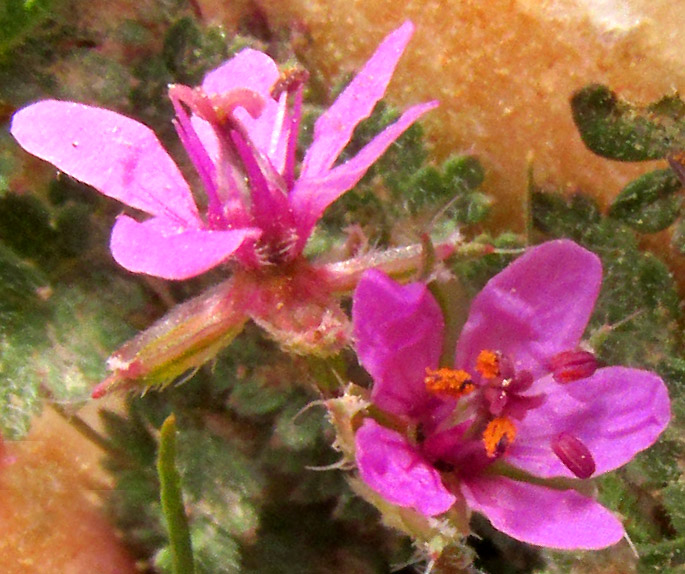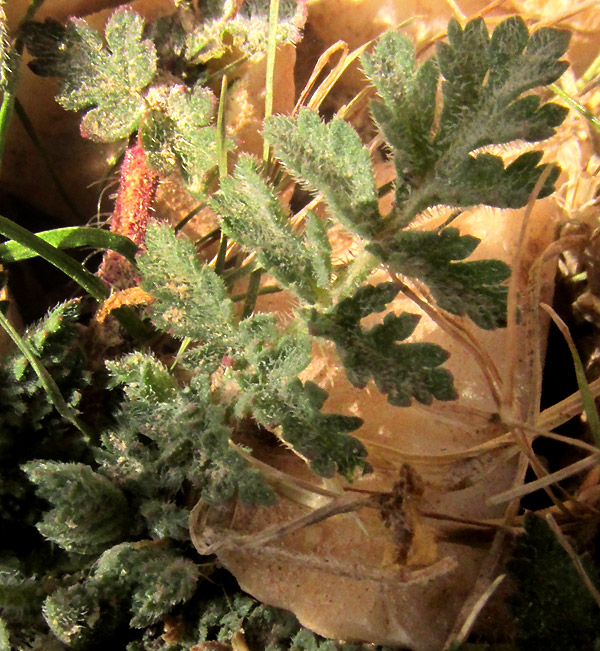Excerpts from Jim Conrad's
Naturalist Newsletter
Entry from field notes dated June 28, 2023, taken beside gravel road running beside the crest of the ridge rising on the southwestern side of Curva de la Doctorcilla, which is near km 18 on the branch road beginning at El Campamento and continuing to El Doctor, and which is numbered Hwy 120, though it branches off the main Hwy 120 running between San Juan del Río and Jalpan; limestone bedrock; elevation ~2930m (~9600 ft), Querétaro, MÉXICO, (N20.85971°, W99.60541°)
COMMON STORK'S-BILL

Emerging from gravel beside the one-lane road cut into the ridgetop's limestone, the above wildflower was so small and low-growing, and its foliage so pale with dust, that its two wisteria-purple flowers almost went unnoticed. This was a very dry habitat during a severe drought, and so exposed to wind rushing across the ridge crest just a stone's throw upslope, and intense sunlight, that one had to admire this plant's ability to survive.

The flowers were classic 5-5-5ers -- five sepals, five petals and five stamens -- even with the styles 5-divided, each style arm bearing a pollen-receiving stigmatic surface. The sepals' conspicuous stiff, broad-based hairs, or trichomes, were noteworthy. Certain anthers were more mature than others, and some anthers were missing, maybe bitten off by a bug, or maybe they just never developed.

The leaves were distinctively "ferny" -- pinnately divided with the pinnae themselves deeply divided, and those divisions themselves shallowly lobed along their margins. Their dense cover of stiff trichomes, helped protect against temperature extremes, desiccating wind and intense sunlight.
People in temperate climates nearly everywhere on Earth, where it's not too hot, too cold, too wet or dry, and who pay attention to their local plants, may recognize this species as one of their common roadside "weeds." Especially if our plant had been older, bearing its schizocarp-type fruits with their long, stiff, slender "beaks" projecting far above their calyxes, identification would have been easier, for this is the commonly occurring Common Stork's-bill, ERODIUM CICUTARIUM, a member of the Geranium Family, the Geraniaceae.
Common Stork's-bills are Old World natives now naturalized in the New World. They can grow up to about 40cm tall (16 inches), and produce numerous stems bristling with stork-bill bearing fruits. The plants are annuals, and ours hasn't had enough growing time to produce fruits.
If you can recognize Common Stork's-bill's distinctive leaves, early in the growing season before flowers form, the leaves can be eaten raw or cooked as a potherb -- if they're not contaminated by pollutants or chemicals meant to kill organisms. Raw, they're good in salads or on sandwiches, plus they can be added to soups.
The whole plant is astringent (causing tissue to contract or pucker) and haemostatic (retards or stops bleeding). As such, the online Atlas de las Plantas de la Medicina Tradicional Mexicana reports that in Mexico, despite its not being introduced here until the Spanish conquest, the plant is highly regarded as medicinal. Among its many uses are the securing of loose teeth, and dealing with angina, inflamed throat, kidney inflammation, ulcers, diarrhea, stomachache, earache, and to end pregnancy. Though in some cases poultices of mashed leaves are placed on the body, mostly decoctions are made for drinking, by concentrating the plant's chemicals in hot or boiling water.